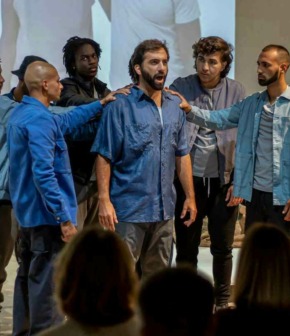Community dialogue

It is flexible because it is in the control of the people who are doing it. It is also liable to change as it progresses, because those same people change through their interaction.
It can be imagined as a spectrum that reflects the degree of control exercised by professional and non-professional artists. Because, at its best, co-creation is empowering, projects often move on that spectrum during their lifetime.
The three exploratory operas all took different approaches to co-creation because they all interpreted it in their own way. That allowed for many illuminating contrasts to emerge. As case studies, they offer crucial knowledge to opera professionals who are interested in using co-creation as a pathway to transformative opera experiences or social inclusion.
LICEU’s approach to co-creation was shaped by the scale of the task they took on, and the risks involved. So co-creation in this exploratory opera was led by the professional artists, who retained primary control of the production. At the same time, they had to adapt their practice and expectations in many ways to meet the needs of the non-professional artists.
A small example illustrates the principle. The Foyer Room is used to serve drinks and refreshments during the interval at the Liceu. For La Gata Perduda, with its cast of hundreds, it was needed as dressing rooms. So catering was reduced to soft drinks and potato chips sold for €2 from temporary stands in the corridors.
A financial loss for the theatre, and not what people usually expect from a night at the opera, but a practical and egalitarian solution that made new audiences feel welcome.
Each element—from the libretto written by playwright Victoria Spunzberg from conversations with local people to the costumes produced with local NGOs—found its own balance in co-creating work that everyone could feel part of. The Liceu’s normal production process had to change to accommodate hundreds of participants and the performance itself emerged from their interaction with the professional artists and with each other.
In producing what we believe will be the world’s first virtual reality community opera, the Irish National Opera community opera prioritised technological and artistic innovation. The INO experimental opera tested the potential of virtual reality headsets to offer an artistic experience which, while clearly not the same as live opera, is a powerful alternative.
The difference with broadcast, recording and streaming technologies is that a VR opera is not a less rewarding reproduction of something that has existed in an original form. It is an experience created for and existing only in the VR platform. It is not opera—in the sense of unmediated sung drama—but nor is it an echo of it. A VR opera is a new artistic experience that stands or falls on its own merits.
The co-creation process began during the Covid-19 pandemic, which meant that four-week workshop blocks focusing on creative writing, music and design with communities were moved online. The co-creation process was facilitated by professional artists and worked very well to produce creative ideas, music and imagery that would be used as raw material for the composition by Finola Merivale and Jody O’Neil.
The biggest challenge for co-creation was in the VR work itself, because it is as technically dependent as composing classical music.
It was not easy to find ways of opening up these aspects of the production to meaningful co-creation, especially when few of those involved had a clear sense of what a VR opera might be. Finola Merivale used material created in workshops with non-professional artists in her score for Out of the Ordinary, weaving their ideas and sound sketches into her composition. She also wrote parts specifically suited for three non-professional musicians. The key was to keep trying, and seeing that even a small task – like creating movements in a motion capture suit – could give people a strong sense of involvement, as well as opening doors onto new worlds for them.
Co-creation in Portugal was easier because of the smaller numbers of people involved and the tight community, but the prison situation brought other difficulties. There was time and freedom to explore and the result was a production made entirely with and about the communities of the prison, telling a story developed in workshops with the inmates. The workshops brought beatbox and rap into the performances, while the young men’s shared stories of loss, separation and choice defined the libretto.
The professional artists supported them in doing that to the highest standard of art and truth. In this trial, it was the librettist and the composers who found the co-creation challenging, because here, the community was almost in the role of a commissioner or a client whose wishes the professional artists needed to meet.
Artistically, the experimental opera in a Portuguese prison breaks new ground in co-creating the opera with four different and not necessarily mutually-sympathetic groups: the young inmates; prison guards and staff; relatives, friends and former inmates; and residents of Leiria. The opera had to accommodate each group’s ideas, hopes and needs in a form that was artistically compelling to audiences who may have no connection with the experiences from which it came. The participants were involved in all aspects of the co-creation and production processes, including the narrative, composition, design, rehearsal and performance.
The participants were involved in all aspects of the co-creation and production processes, including the narrative, composition, design, rehearsal and performance.
In terms of technology, the Co-Creation Stage tool which was created as part of Traction became a means of connecting these groups and enabling them to co-create together.